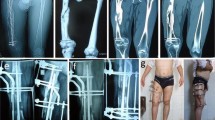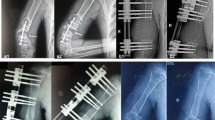Abstract
Introduction
Ilizarov bone transport for large bone defect is challenging and may end in distraction osteogenesis failure.
Material and methods
Ten forearm and seven tibial defect cases with failed regeneration due to ischaemia during bone transport were studied retrospectively. Mean forearm and tibial defects were 5.5 ± 0.8 and 7.6 ± 1 cm respectively, or 22.3 ± 3.6 and 20 ± 2.3% as compared with healthy segments. Most patients had numerous previous operations (2.6 ± 0.5 and 3.4 ± 0.8 per patient, respectively), extensive scars locally and post-traumatic neuropathy. There were seven infected defects. Mechanical solutions used were (1) additional osteotomy and transport of the fragment to compact the ischaemic regenerate (10 forearms, 4 tibias) and (2) compaction of the connective tissue layer in the tibial regenerate with either two 5-mm steps (two cases) or gradually (one case).
Results
Bone integrity was restored in all the cases. Complete compensation of the defects was achieved in 12 patients with the first technique. Two patients with 8-cm ulna defects remained with residual discrepancy. In the forearm, mean compaction was 1.7 ± 0.4 cm. It took 25.7 ± 5.4 days followed by an average fixation period of 107.1 ± 11.8 days. In the tibia, mean longitudinal compaction by distraction measured 1.7 ± 0.8 cm. The second technique ended up with an acceptable shortening of 1 cm in two cases. Four centimeters were compressed in the third case gradually.
Conclusion
The technical solutions used for mechanical effects on the ischaemic distraction regenerate resulted in its rescue and bone union in all the cases.





Similar content being viewed by others
References
Polyzois D, Papachristou G, Kotsiopoulos K, Plessas S (1997) Treatment of tibial and femoral bone loss by distraction osteogenesis. Experience in 28 infected and 14 clean cases. Acta Orthop Scand Suppl 68(275):84–88
Tsuchiya H, Tomita K (2003) Distraction osteogenesis for treatment of bone loss in the lower extremity. J Orthop Sci 8(1):116–124
Azzam W, Atef A (2016) Our experience in the management of segmental bone defects caused by gunshots. Int Orthop 40(2):233–238
Liodakis E, Kenawey M, Krettek C, Ettinger M, Jagodzinski M, Hankemeier S (2011) Segmental transports for posttraumatic lower extremity bone defects: are femoral bone transports safer than tibial? Arch Orthop Trauma Surg 131(2):229–234
Tetsworth K, Paley D, Sen C, Jaffe M, Maar DC, Glatt V, Hohmann E, Herzenberg JE (2017) Bone transport versus acute shortening for the management of infected tibial non-unions with bone defects. Injury 48(10):2276–2284. https://doi.org/10.1016/j.injury.2017.07.018
DeCoster TA, Gehlert RJ, Mikola EA, Pirela-Cruz MA (2004) Management of posttraumatic segmental bone defects. J Am Acad Orthop Surg 12(1):28–38
Xu K, Fu X, Li YM, Wang CG, Li ZJ (2014) A treatment for large defects of the tibia caused by infected nonunion: Ilizarov method with bone segment extension. Ir J Med Sci 183(3):423–428. https://doi.org/10.1007/s11845-013-1032-9
Borzunov DY (2012) Long bone reconstruction using multilevel lengthening of bone defect fragments. Int Orthop 36(8):1695–1700
Nakano-Matsuoka N, Fukiage K, Harada Y, Kashiwagi N, Futami T (2017) The prevalence of the complications and their associated factors in humeral lengthening for achondroplasia: retrospective study of 54 cases. J Pediatr Orthop B 26(6):519–525. https://doi.org/10.1097/BPB.0000000000000428
Robert Rozbruch S, Weitzman AM, Tracey Watson J, Freudigman P, Katz HV, Ilizarov S (2006) Simultaneous treatment of tibial bone and soft-tissue defects with the Ilizarov method. J Orthop Trauma 20(3):197–205
Venkatesh KP, Modi HN, Devmurari K, Yoon JY, Anupama BR, Song HR (2009) Femoral lengthening in achondroplasia: magnitude of lengthening in relation to patterns of callus, stiffness of adjacent joints and fracture. J Bone Joint Surg Br 91(12):1612–1617. https://doi.org/10.1302/0301-620X.91B12.22418
Aronson J (1994) Temporal and spatial increases in blood flow during distraction osteogenesis. Clin Orthop Relat Res 301:124–131
Choi IH, Chung CY, Cho TJ, Yoo WJ (2002) Angiogenesis and mineralization during distraction osteogenesis. J Korean Med Sci 17(4):435–447
Morgan EF, Hussein AI, Al-Awadhi BA, Hogan DE, Matsubara H, Al-Alq Z, Fitch J, Andre B, Hosur K, Gerstenfeld LC (2012) Vascular development during distraction osteogenesis proceeds by sequential intramuscular arteriogenesis followed by intraosteal angiogenesis. Bone 51(3):535–545. https://doi.org/10.1016/j.bone.2012.05.008
Kanczler JM, Oreffo RO (2008) Osteogenesis and angiogenesis: the potential for engineering bone. Eur Cell Mater 15:100–114
Aronson J (2007) Basic science and biological principles of distraction osteogenesis. In: Rozbruch RS, Ilizarova S (eds) Limb lengthening and reconstruction surgery. Informa, New York, pp 19–42
Alzahrani MM, Anam EA, Makhdom AM, Villemure I, Hamdy RC (2014) The effect of altering the mechanical loading environment on the expression of bone regenerating molecules in cases of distraction osteogenesis. Front Endocrinol (Lausanne) 5:214. https://doi.org/10.3389/fendo.2014.00214
Sabharwal S (2011) Enhancement of bone formation during distraction osteogenesis: pediatric applications. J Am Acad Orthop Surg 19(2):101–111
El-Alfy B, El-Mowafi H, Kotb S (2009) Bifocal and trifocal bone transport for failed limb reconstruction after tumour resection. Acta Orthop Belg 75(3):368–373
Li R, Saleh M, Yang L, Coulton L (2006) Radiographic classification of osteogenesis during bone distraction. J Orthop Res 24(3):339–347
Kojimoto H, Yasui N, Goto T, Matsuda S, Shimomura Y (1988) Bone lengthening in rabbits by callus distraction. The role of periosteum and endosteum. J Bone Joint Surg Br 70(4):543–549
Isaac D, Fernandez H, Song HR, Kim TY, Shyam AK, Lee SH, Lee JC (2008) Callus patterns in femur lengthening using a monolateral external fixator. Skelet Radiol 37(4):329–334. https://doi.org/10.1007/s00256-007-0406-3
Emara KM, Ghafar KA, Al Kersh MA (2011) Methods to shorten the duration of an external fixator in the management of tibial infections. World J Orthop 2(9):85–92. https://doi.org/10.5312/wjo.v2.i9.85
Kenawey M, Krettek C, Liodakis E, Meller R, Hankemeier S (2011) Insufficient bone regenerate after intramedullary femoral lengthening: risk factors and classification system. Clin Orthop Relat Res 469(1):264–273. https://doi.org/10.1007/s11999-010-1332-6
Farr S, Mindler G, Ganger R, Girsch W (2016) Bone lengthening in the pediatric upper extremity. J Bone Joint Surg Am 98(17):1490–1503. https://doi.org/10.2106/JBJS.16.00
Shyam AK, Singh SU, Modi HN, Song HR, Lee SH, An H (2009) Leg lengthening by distraction osteogenesis using the Ilizarov apparatus: a novel concept of tibia callus subsidence and its influencing factors. Int Orthop 33(6):1753–1759. https://doi.org/10.1007/s00264-008-0660-6
Acknowledgements
The authors would like to thank Tatiana Malkova from the medical information service of our institute for her contribution to the literature review and English language interpretation.
Author information
Authors and Affiliations
Corresponding author
Ethics declarations
Conflict of interest
The authors declare that they have no conflict of interest.
Ethical approval
All procedures performed in studies involving human participants were in accordance with the ethical standards of the institutional and/or national research committee and with the 1964 Helsinki declaration and its later amendments or comparable ethical standards.
Informed consent
For this type of study formal consent is not required.
Rights and permissions
About this article
Cite this article
Borzunov, D.Y., Shastov, A.L. Mechanical solutions to salvage failed distraction osteogenesis in large bone defect management. International Orthopaedics (SICOT) 43, 1051–1059 (2019). https://doi.org/10.1007/s00264-018-4032-6
Received:
Accepted:
Published:
Issue Date:
DOI: https://doi.org/10.1007/s00264-018-4032-6




